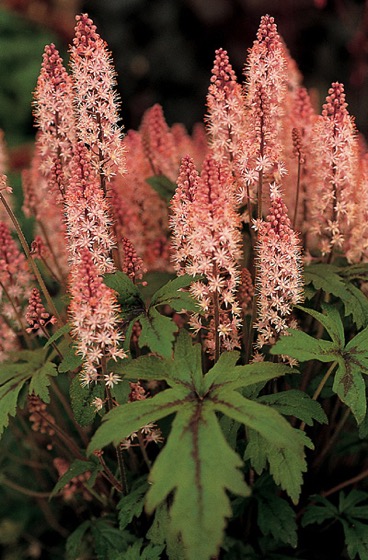Tiarella ‘Pink Skyrocket’
Another Pinterest find from Kelhm’s Song Sparrow Farm and Nursery. There are a wide variety of Tiarella’s available from a variety of vendors, it seems.
What are your thoughts on this Interesting Plant? Drop a note in the comments!
Tiarella trifoliata, commonly called threeleaf foamflower,[1] laceflower,[2] or sugar-scoop,[2] is a dicot in the family Saxifragaceae.
It is native to the low to moderate elevation moist forests of western North America, from northern California to Montana and western Canada.
Tiarella trifoliata is a perennial herb that grows in the late spring.
The flowers are bell-shaped, white, solitary from an elongate, leafless panicle. The calyx lobes are 1.5–2.5 mm and petals are 3–4 mm. Basal leaves are 15–80 mm long and up to 120 mm wide, trifoliate or palmately 3- to 5-lobed. Cauline leaves are infrequent and much smaller.[1] — Wikipedia
More information on Tiarella and Tiarella ‘Pink Skyrocket’):
- Tiarella at Wikipedia
- Tiarella ‘Pink Skyrocket’ at Klehm’s Song Sparrow Farm
- Tiarella ‘Pink Skyrocket’ at Monrovia
- Tiarella ‘Pink Skyrocket’ at Northern Shade Gardening
- Bacopa monnieri (Water hyssop)
- Lycoris squamigera (Naked Lady Lily)
- Kong Coleus (Plectranthus/Solenostemon scutellarioides “Kong Series”)
- Crassula plegmatoides
- Agave victoriae-reginae
- Mountain Cornflower (Centaurea montana)
- Euphorbia ‘Black Bird’
- Firecracker vine (Ipomoea lobata)
- Eryngium yuccifolium
- Dahlia ‘Karma Choc’
- Echeveria Agavoides
- Jerusalem Sage (Phlomis fruticosa)
- Hummingbird Sage (Salvia spathacea)
- Seaside Daisy, Beach Aster (Erigeron glaucus)
- Toyon (Heteromeles arbutifolia)
- California Lilac (Ceanothus)
- Bigberry Manzanita (Arctostaphylos glauca)
- Douglas Iris (Iris douglasiana)
- Malva Rosa (Lavatera assurgentiflora)
- Baby Blue-Eyes (Nemophila)
- Coral Bells or Alum Root (Heuchera)
- Deer Grass (Muhlenbergia rigens)
- Echeveria ‘Lola’
- View all past “Interesting Plant” posts
Interesting Plant is a series from A Gardener’s Notebook blog and podcast that highlights the most interesting plants I find in my Internet and real-world travels — Douglas

